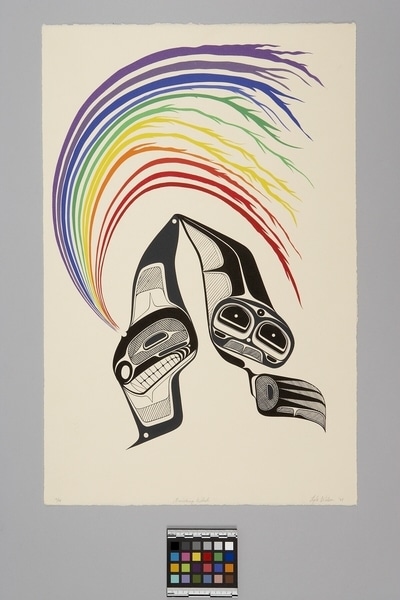Frolicking Whale Item Number: Nb3.1392 from the MOA: University of British Columbia

Description
Black and very dark grey stylized image with twelve variously and brightly coloured (in rainbow sequence) bands sweeping across the top from the left in an expanding arch, each band having branch-like projections towards the end. The image below is in two parts, coming together at the centre top. On the left, there is an ovoid profile face on an angle with crosshatching around the eye, a semi-circle 'spout' from which multi-coloured bands extend, an ovoid nose, even teeth rows with prominent canines, and above and below the head, there are u forms in bent u form. Centre u form has diagonal lines across, closest to head is split, outer is dark grey, the top is slightly bent, with a small circle at the end, bottom ends in sharp point with a circle just before. Right side has an ovoid frontal face on an angle with two diagonally striped u forms in split u, beside the band above the ovoid tapering to a point at the top. Below the face, there is a hand with diagonal striping between the digits and the crosshatched ovoid palm. Written pencil inscription across bottom reads '15/47 Frolicking Whale Lyle Wilson '81'. The print is on a vertically rectangular, light white-brown deckle edged paper piece.
History Of Use
Northwest Coast serigraphs are a contemporary art form, deriving from early 20th century drawings of traditional crest and decorative designs, commissioned by anthropologists and undertaken by artists such as Charles Edenshaw. Residential schools reinforced the medium, while discouraging the use of traditional themes. An important series of traditional designs in coloured pencil and watercolour were done by Mungo Martin for UBC in 1949-50. The 1960's saw the rapid growth of prints, first in unlimited poster editions, and later with the establishment of the Gitanmaax School of Northwest Coast Indian Art at 'Ksan (1967), and of the Northwest Coast Indian Artists Guild (1977), limited edition art runs became the standard. Northwest Coast silkscreen prints are part of the mainstream art market, as well as, functioning within the native context as potlatch gifts, and commemorative prints. Although, there are distinctive regional styles, individual artists may work in several styles, or apply unique themes and variations to specific works.
Cultural Context
contemporary art
Item History
- Made by Lyle Wilson (Maker) in Kitamaat, British Columbia, Canada during 1981
- Owned by Lyle Wilson before August 7, 1987
- Received from Museum of Anthropology Shop Volunteers (Funding source) and Lyle Wilson (Seller) on August 7, 1987
What
- Name
- Frolicking Whale
- Identification Number
- Nb3.1392
- Type of Item
- Manufacturing Technique
- silkscreened
- Overall
- height 56.7 cm, width 36.9 cm, depth 0.1 cm
Who
- Culture
- Haisla
- Creator
- Lyle Wilson (Maker)
- Previous Owner
- Lyle Wilson
- Received from
- Museum of Anthropology Shop Volunteers (Funding source) and Lyle Wilson (Seller)
Where
- Holding Institution
- MOA: University of British Columbia
- Made in
- Kitamaat, British Columbia, Canada
When
- Creation Date
- during 1981
- Ownership Date
- before August 7, 1987
- Acquisition Date
- on August 7, 1987
Other
- Item Classes
- works on paper
- Condition
- good
- Accession Number
- 1226/0004